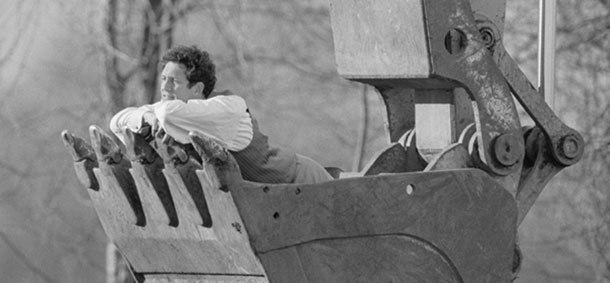Freud taught us that slips of the tongue are important markers of our inner world. In the introductions to Wednesday night’s collaboration between BodyVox and Chamber Music Northwest, BodyVox co-artistic director Jamey Hampton referred to his collaborator as “Country Music Northwest.” He caught, corrected and explained himself, but as the first part of the “In Motion” program unfolded, “Country Music” seemed fair enough: His slip was “true.”
That isn’t to say that “In Motion” was a hoedown or something, but as the young players of Chamber Music Northwest’s Protege Project (Katie Hyun and David Southorn) bent to their Bartok in the first dance, Eric Skinner’s “Serein”, selections from 44 Duos for Two Violins, Bartok’s deep knowledge of the folk music of Middle Europe seemed intimately connected to Southern America’s folk music — country music.
Skinner’s choreography, light and winsome, caught that, too, somehow, not with folk dance squares or lines, but in its appropriation of vernacular movement, informal and skipping along, clever at times and even demanding, but never serious or self-important. Skinner’s own solo said it: We are here, we’re having fun, we love the music, we have to move. Now country music has its lamentations, haunting and existentially sad, but when the fiddles really warm up to a reel, Skinner’s approach is exactly the right one.
The Protege musicians were perfect for this collaboration, throwing themselves into the performance aspect of the evening. So, percussionists Candy Chiu, John Corkill and Jon Greeney did some hand dancing in “Table Music” by Thierry de Mey. Their hands deftly moving the miked “boards” on which they built their rhythms, a bright spotlight capturing every thrum, slap, knuckle rap and finger tap. I thought for a second of those guys who “play” their face — yes, a country music sub-genre. But mostly, I liked the spirit.
And then the program sequed to Marin Marais “La Folia Variations,” which showed us how closely French court music and dance from the 17th century relates to country music. For that piece, flutist Sooyun Kim had transcribed the dance notation from the time, the little steps and turns, and performed them as she played her flute, accompanied by the beats of Chiu and Corkill. Nothing too fancy, mind you, nothing to interfere with her fine flute playing, but a light and constant movement on the tippy toes that emphasized the movement of the music.
After that, we had Hampton and Ashley Roland’s justifiably famous Deere John, a film directed by Mitchell Rose, that captures the love of a man for his work machine, in this case a massive excavator, for which Amy Yang provided the live accompaniment, which was Camille Saint-Saens’ “The Swan.” But, yes, heavy machinery.
S.O.S., Hampton’s take on the Titanic, changed course a bit. Sibelius’ “Valse Triste” isn’t even a little bit country, and the dance is one of the quiet ones in the BodyVox repertoire, but then we headed into another Mitchell Rose film, Islands in the Sky, which is a choreography of cherry pickers or bucket trucks in a big field to the music of Jules Massenet’s familiar “Meditation from Thais.” The somber music, the “serious” faces of the dancers doing arabesques high above the ground in their little buckets contrasts nicely with the general absurdity of those big machines employed in this particular way.
The last dance on the Chamber Music Northwest/BodyVox program was the softly humorous Foreign Tales, an exploration of aggressively telescoping hoop skirts danced to Debussy and Ravel. At some point in the middle, I had a re-thought. You know, a previous idea or observation that pops into your head when you see something that supports or refutes it.
I remembered how much of my early exposure to classical music came as background music to the flood of cartoons I watched on TV and at the movies as a young kid in the ‘50s. Disney, sure, but bits of opera and symphonies, the stirring bits, popped up all the time behind the craziest cartoons.
As I looked around the audience, I saw just a few younger faces, and I thought what a good introduction to classical music this particular collaboration would be. The music was tuneful and familiar, the dance alternately joyful and comic and absurd. It wasn’t quite in the spirit of those madcap animated films, which revved up to truly manic levels and which I found totally consuming, but close enough. And you could imagine BodyVox coming up with more slapstick, if called upon.
Let’s say I was a classical music organization that wanted to plant classical music into the sub-consciousnesses of today’s kids. Well, I could do worse than commissioning some concerts with BodyVox aimed directly at that audience. Also Imago, Tears of Joy, Do Jump! and various other groups in town that perform for the younger set. The classical soundtrack would lodge in their brains the same way it did in mine.
Hey, come on: Daffy Duck singing “Figaro” is one of the key moments in my life in opera!

